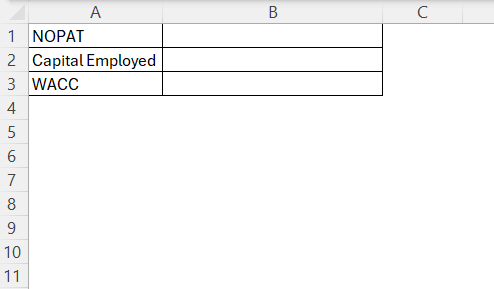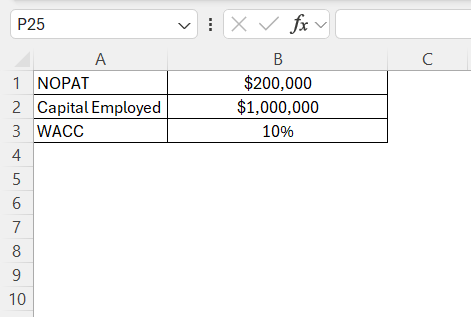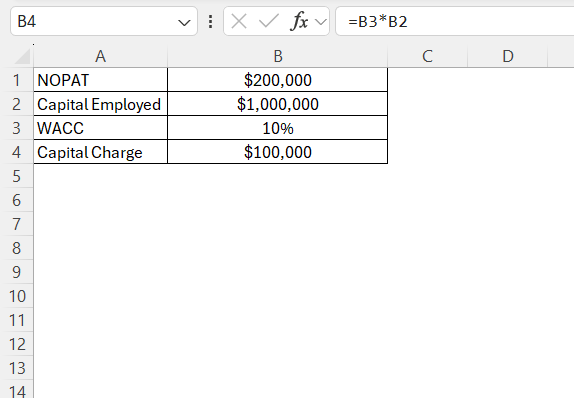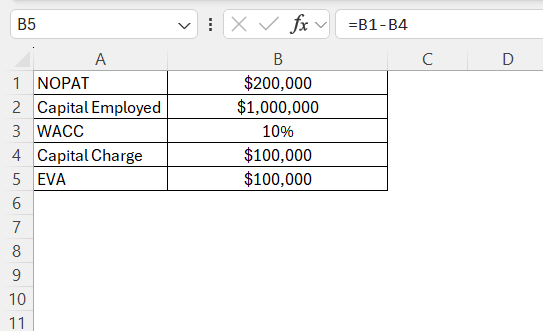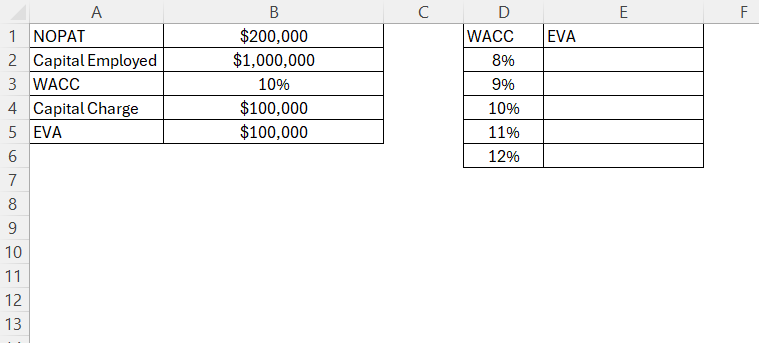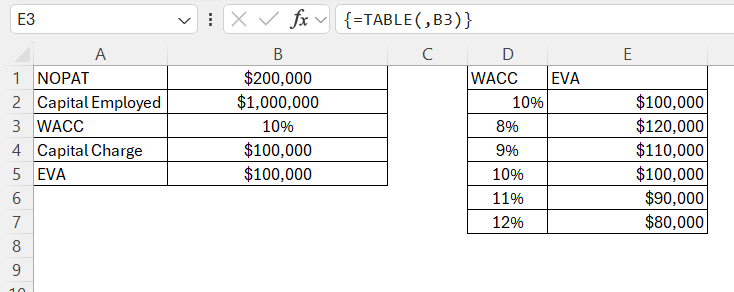As someone who frequently uses Excel for financial analysis, I find Economic Value Added (EVA) to be a valuable metric for assessing a company’s true financial performance. EVA provides insights beyond traditional profit measures by considering the cost of capital, making it a powerful tool for determining if a company truly generates value for its shareholders.
In this guide, I’ll walk you through how to calculate Economic Value Addition in Excel, breaking down each step to make it as straightforward as possible.
Key Takeaways:
- EVA measures true profitability by considering the cost of capital, making it a valuable metric for assessing company performance beyond traditional profit metrics.
- Calculating EVA in Excel involves finding Net Operating Profit After Tax (NOPAT), Capital Employed, and the Weighted Average Cost of Capital (WACC).
- Positive EVA signals value creation for shareholders, while a negative EVA may indicate a need for strategic changes to improve returns.
- EVA can drive better capital allocation by highlighting unproductive assets and promoting efficient financial management.
- Performing sensitivity analysis on EVA in Excel can help you see how changes in WACC or NOPAT affect economic value, aiding informed decision-making.
Table of Contents
Introduction to Economic Value Added (EVA)
The Basics of EVA
Understanding Economic Value Added (EVA) is pivotal for anyone striving to gauge a company’s profitability more precisely than traditional metrics allow. EVA is distinguished by its focus on calculating whether a company is generating wealth beyond the requisite returns demanded by its investors.
It takes into account the net operating profit after taxes but digs deeper by subtracting the capital’s cost to uncover the added economic value.
Why EVA is a Keystone in Profit Maximization
EVA stands at the forefront of profit maximization strategies due to its comprehensive approach to measuring a company’s financial performance. By factoring in the cost of capital, EVA ensures that we’re not just considering the absolute profit figures but also whether these profits exceed the minimum return expected by investors.
It aligns with the ultimate business goal of wealth maximization, highlighting that generating sustainable and long-term value takes precedence over short-term profit gains. This intrinsic nature to stimulate wealth creation makes EVA an indispensable tool for businesses intent on maximizing shareholder value.
The Pillars of EVA Calculation
Unraveling the EVA Formula
When we unravel the EVA formula, we’re essentially breaking down a company’s financial performance to its core—assessing how effectively operational profits cover the costs of capital. To comprehend it, we need to recognize each component:
- NOPAT signifies Net Operating Profit After Tax, reflecting the profits from operations after tax adjustments.
- WACC, or Weighted Average Cost of Capital, embodies the overall cost of financing, considering both equity and debt.
- Invested Capital includes shareholder’s equity and debt, minus any non-operating assets like excess cash.
The EVA formula, NOPAT minus the product of WACC and Invested Capital, provides a stark number reflecting pure value creation.
EVA=Net Operating Profit After Taxes (NOPAT)−(Capital Employed×WACC)
A positive EVA indicates successful investment management above the threshold set by capital costs, while a negative EVA points to a need for strategic realignment.
Sleuthing Through Adjustments in Accounting
Diving into EVA calculation requires me to be somewhat of a financial detective, sleuthing through accounting statements to identify adjustments that align with economic reality, rather than just accounting conventions. Recognizing that certain costs, like R&D and advertising, can propel long-term value, these are often capitalized instead of being marked as mere expenses.
Similarly, I add back non-cash expenses, such as depreciation, to profits, ensuring that only cash operations affect the EVA. Accounting for deferred taxes and provisions, I carefully adjust for the actual cash impact rather than accrual estimates. Lastly, operating leases are capitalized to reflect their ongoing asset and liability implications.
These adjustments are crucial to depict an accurate picture of a company’s economic achievements.
Step by Step Guide to Calculate EVA
Setting Up Your Data
Let’s start by setting up the necessary data in Excel.
STEP 1: In Column A, list the required values – “NOPAT,” “Capital Employed,” and “WACC.”
STEP 2: In Column B, enter the respective values for each component:
- NOPAT: This can be found on your company’s financial statements. Let’s assume we have $200,000.
- Capital Employed: This is typically the sum of equity and debt. We’ll use $1,000,000 for this example.
- WACC: You can calculate WACC based on your company’s equity and debt costs. For this guide, I’ll use 10%, or 0.10.
Calculating the Capital Charge
The capital charge represents the cost of capital that investors require as a minimum return on their investment. Enter the formula to calculate the capital charge by multiplying the Capital Employed by the WACC.
=B2 * B3
Here, we multiply Capital Employed ($1,000,000) by WACC (0.10), resulting in a Capital Charge of $100,000.
Calculating EVA
Now, we can calculate EVA by subtracting the Capital Charge from NOPAT.
=B1 – B4
In this case, we’re subtracting the Capital Charge ($100,000) from NOPAT ($200,000), giving us an EVA of $100,000. EVA of $100,000 means that after covering the cost of capital, the company still has an additional $100,000. This positive EVA suggests that the company is indeed creating value for its shareholders.
Sensitivity Analysis with Data Tables
To make your analysis more robust, consider running a sensitivity analysis to see how changes in WACC or NOPAT would impact EVA. Here’s a quick way to do this:
STEP 1: Select a range of WACC values (e.g., from 8% to 12%) and place them horizontally across a row.
STEP 2: Using Excel’s Data Table function under the “What-If Analysis” tool, you can observe how fluctuations in WACC impact your EVA, helping you make more informed decisions.
STEP 3: Link the EVA calculation to the WACC in your data table and let Excel calculate how EVA changes with different WACC values.
Case Study Companion
A Real-World Example of EVA at Work
I vividly recall analyzing an EVA case study where a manufacturing company utilized EVA to overhaul its financial strategy. The firm was traditionally fixated on gross margins, yet struggling with profitability. By implementing EVA, it pivoted focus towards capital efficiency, uncovering that significant amounts of capital were tied up in unproductive assets.
The company launched efforts to reallocate capital, divest from low-performing segments, and streamline operations. This yielded a substantial EVA increase over several quarters, demonstrating the power of EVA to instigate transformative financial management and boost shareholder value.
Lessons Learned: Improving Future EVA Outcomes
The lessons learned from EVA analysis are integral to steering a company’s financial ship towards more profitable horizons. The key learnings often include recognizing the importance of not just profits, but profits in excess of capital costs. Companies discover the value of investing in projects that yield rates of return well above the weighted average cost of capital.
Another lesson is to practice proactive capital management, ensuring capital isn’t left idly in non-performing assets. Continuous operational efficiency, reducing avoidable costs, and optimizing tax strategies also emerge as pivotal strategies. These experiences embed a culture of value creation that aligns management actions with shareholder interests, ultimately leading to improved EVA outcomes.
FAQ: Your EVA Questions Answered
What is the formula for economic value addition?
The formula for economic value added (EVA) is Net Operating Profit After Tax (NOPAT) minus the product of Capital Invested and the Weighted Average Cost of Capital (WACC). Mathematically, it’s expressed as EVA = NOPAT – (Capital Invested x WACC). This calculation reveals the true economic profit of a company after all operating costs and capital costs have been accounted for.
What Exactly Is Economic Value Added?
Economic Value Added (EVA) is a measure of a company’s financial performance that calculates the value created beyond the required return of the company’s shareholders. It is essentially what remains after subtracting the cost of capital from the company’s operating profits (after taxes). EVA is a robust tool for assessing how effectively a company is generating wealth with the resources at its disposal.
How Can I Apply EVA to My Business or Investments?
To apply EVA to your business or investments, start by determining the Net Operating Profit After Tax (NOPAT) of the business. Then, calculate the capital invested in the business and ascertain the appropriate Weighted Average Cost of Capital (WACC). With these figures, apply the EVA formula: EVA = NOPAT – (Capital Invested * WACC). This will help you understand whether investments are surpassing the benchmark set by your capital costs and can guide strategic decisions to enhance value creation.
Are There Any Alternatives to EVA Worth Exploring?
Yes, there are alternatives to EVA that can be considered. Return on Invested Capital (ROIC) and Return on Assets (ROA) offer insights into how efficiently a company uses its capital or assets to generate returns. Free Cash Flow (FCF) focuses on the cash a company produces after accounting for cash outlays to support operations and maintain capital assets. Additionally, Discounted Cash Flow (DCF) analysis can be used to estimate the value of an investment based on its future cash flows. Choosing the right metric depends on the specific analysis needs and the nature of the business or investment.
How do you add economic value?
To add economic value, a company needs to focus on strategies that increase its EVA. This can be achieved by enhancing operational efficiency to boost NOPAT, carefully managing capital expenditures, reducing costs, and optimizing the capital structure to lower WACC. Innovation, better pricing strategies, and expanding into new markets can also drive revenue and profit growth. Essentially, any action that increases profits more than the cost of capital will contribute to a positive EVA, signaling the creation of economic value.
John Michaloudis is a former accountant and finance analyst at General Electric, a Microsoft MVP since 2020, an Amazon #1 bestselling author of 4 Microsoft Excel books and teacher of Microsoft Excel & Office over at his flagship MyExcelOnline Academy Online Course.

